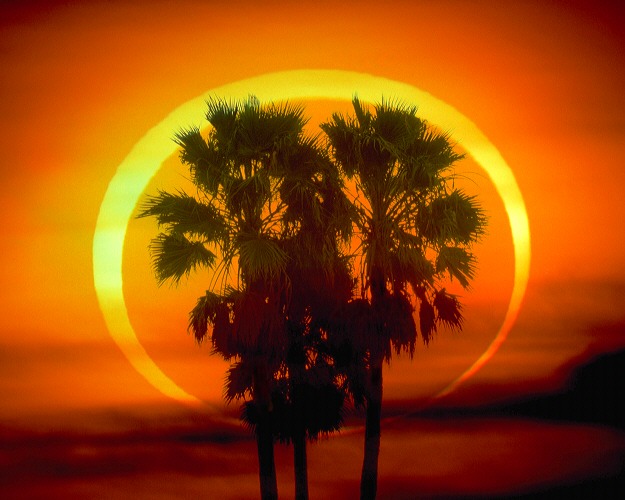Credit: Dennis Mammana
(Skyscapes)
Explanation:
Early on Saturday,
May 31 (UT) the new Moon will
once again slide across the Sun's fiery disk, and
once again an
annular solar eclipse will be the
result -- since the Moon's apparent
diameter
will be a little too small to completely
cover the Sun.
But this time
celestial geometry
has conspired to produce a broad
D-shaped region
for viewing the
annular phase that extends into the far northern hemisphere,
rather than creating a thin track racing across land and sea.
The characteristic ring of fire will be visible from
northern Scotland, Iceland, and parts of Greenland.
Otherwise a partial eclipse will be more widely visible
as across Europe, along with parts of Asia and North America,
the Moon will appear to take a "bite" out of the Sun.
While the northerly observers might certainly expect a
dramatic
view, it will probably not look quite
like this one, recorded with a foreground
of palm trees during a 1992 annular eclipse.
Want to watch Saturday's eclipse on the web?
Check out the planned
webcasts
from Astronet.
1999 2000 2001 2002 2003 2004 2005 2006 2007 |
Январь Февраль Март Апрель Май Июнь Июль Август Сентябрь Октябрь Ноябрь Декабрь |
NASA Web Site Statements, Warnings, and Disclaimers
NASA Official: Jay Norris. Specific rights apply.
A service of: LHEA at NASA / GSFC
& Michigan Tech. U.
|
Публикации с ключевыми словами:
annular solar eclipse - solar eclipse - Солнечное затмение - кольцевое затмение
Публикации со словами: annular solar eclipse - solar eclipse - Солнечное затмение - кольцевое затмение | |
См. также:
Все публикации на ту же тему >> | |
